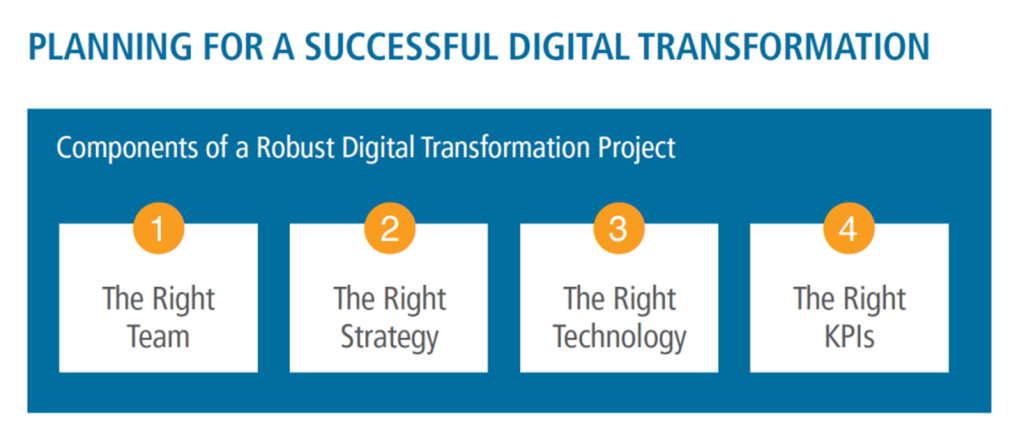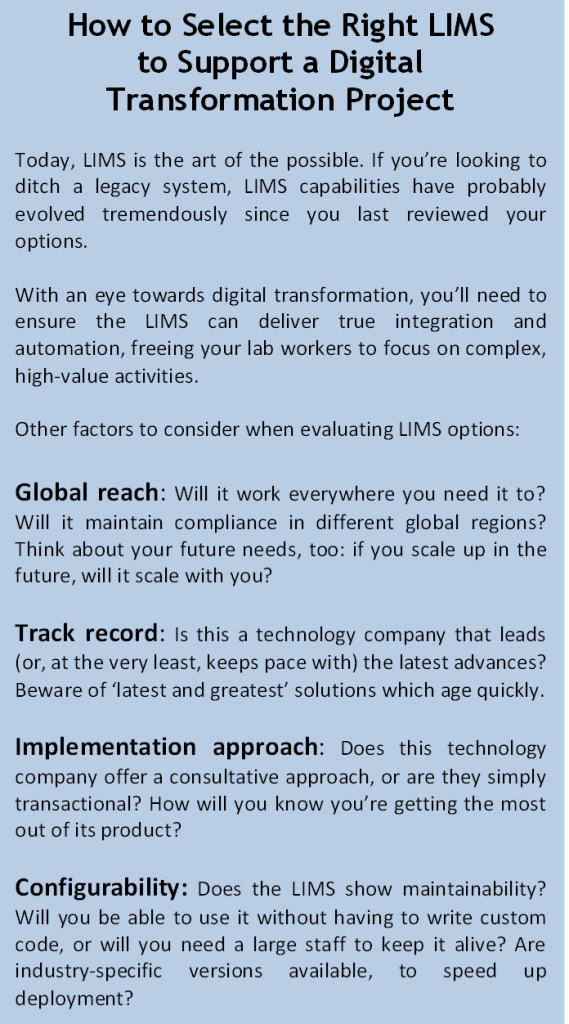
You probably have some questions about how to identify and launch digital transformation in your organization.
Crafting an effective Digital Transformation (DT) strategy requires four key elements: a team, a strategy, the right technology and the appropriate analytics to measure and correct for success.
And just what’s at stake? What’s at the digital transformation journey’s end?
Agility, innovation, and data-driven business growth, for starters.
[Want to understand what the DT hype is all about? Check out our earlier post on digital transformation, or download our free whitepaper, Navigating the Digital Transformation Journey.]

Here are the four how-tos you need in order to implement a successful DT strategy:
1> How to Identify the Right Team
Digital transformation flows downward, meaning support from the highest echelons of your organization is critical.
So who should play a role in defining a digital transformation strategy?
- Top-level leadership teams and boards.
- ‘Transformation-related’ roles, such as CIO and the IT team.
- External consultants, technology partners and trusted advisors.
As you might expect, a successful digital transformation relies on the ability to balance the perspective of both internal and external experts. Internal experts possess front-line knowledge of the interdependent systems undergoing transformation, while external resources bring extensive domain expertise.
Your organization’s leadership team will help drive momentum of the DT process. They will also pave the way internally for broader acceptance of your intended changes.
2> How to Craft the Right Strategy
As we mentioned above, most DT efforts will be incremental. The temptation to ‘go for it’ and reboot everything simultaneously is always there, but that mindset will produce numerous challenges.
From a technology standpoint, your team will need to ensure all systems and platforms are configured to work smoothly together – and that takes time.
 Massive, rapid change also risks creating resistance and uncertainty among your staff.
Massive, rapid change also risks creating resistance and uncertainty among your staff.
Teams faced with the sweeping changes necessary for a true transformation can find themselves at a loss for where to begin. This paralysis can lead some organizations to never begin the process at all. You don’t want to postpone meaningful change or impede business growth.
A properly-crafted strategy will live somewhere between the bold, all-at-once aspirations and the caught-in-the-headlights do-nothing approach. You’ll want to develop an incremental rollout plan. Your plan should include an assessment of which people, processes and technologies are failing to serve – or are under-serving – your organization’s potential.
When you build your DT strategy, outline a plan which best empowers those people, overhauls those processes, and introduces revolutionary technologies to accelerate growth. It’s a matter of determining where a digital transformation can add the most value. Think about reducing redundancies, improving the likelihood of success, removing obstacles and better leveraging data for insights to improve your innovation and speed.
3> How to Identify the Right Technology
In order to select the right technology products and solutions, DT teams must evaluate which business technology will add value and drive interconnectivity. This requires a thorough understanding of your organization’s processes. These should be mapped based on the most ideal flow of information across your company.
Choosing a technology to fit a specific legacy process may hold you back from genuine transformation. This challenge arises most often in organizations with home-grown or highly customized solutions, and it often leads to systems and processes which are difficult to scale, improve or update. The problem can be magnified in labs where heavy customization has created compliance issues.
What’s the answer?
Consider flipping the paradigm. Redefine those heavily-customized processes based on available, best-in-class technology and the latest regulatory guidance (if applicable).
Our most successful customers use their LIMS as a driver for process change. Instead of customizing the out-of-the-box technology, they adapt their processes to suit the platform, improving their ability to stay current with the latest regulatory guidance. (It’s not as complex or painful as it sounds!)
4> How to Measure the Right KPIs
What gets measured, gets better. Developing the right set of key performance indicators (KPIs) helps ensure your company will embrace what works…and fix what doesn’t.
‘Transformation metrics’ which track the success of a digital transformation strategy may be unique to each organization. The best, most effective KPIs are clear, specific and measurable – and they should map back to the business objectives outlined in your strategy.
The Business Journey of Digital Transformation
Digital transformation is no longer a technology journey. It’s a business journey that uses technology as its vehicle to improve agility, foster innovation, and drive business growth.
LabVantage helps organizations eliminate the risks and realize the potential of their digital transformation strategies by providing a highly configurable and uniquely cloud-ready LIMS.
For a closer look at how LabVantage has designed our technology to help labs lead successful digital transformation initiatives, visit Navigating the Digital Transformation Journey.

